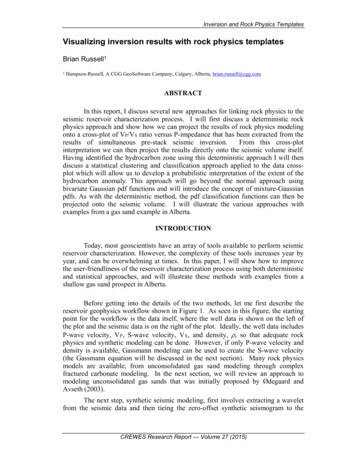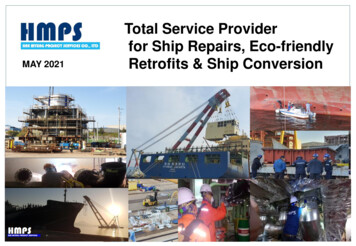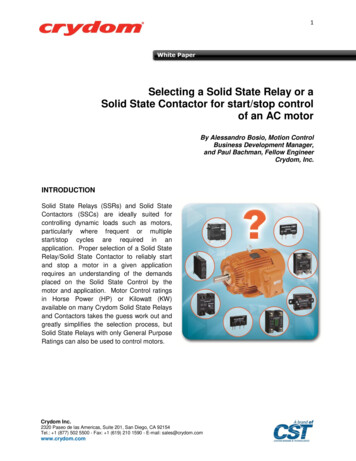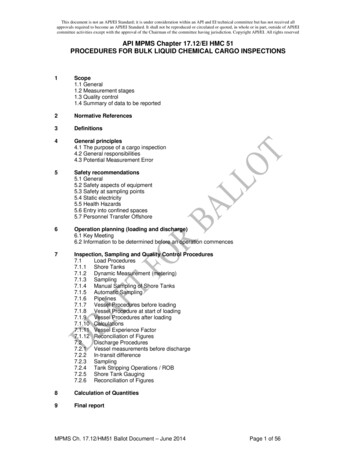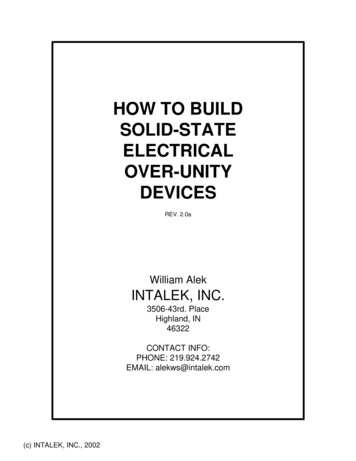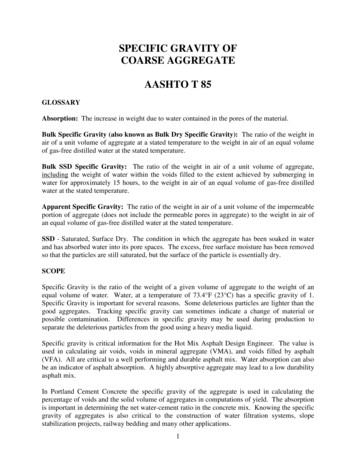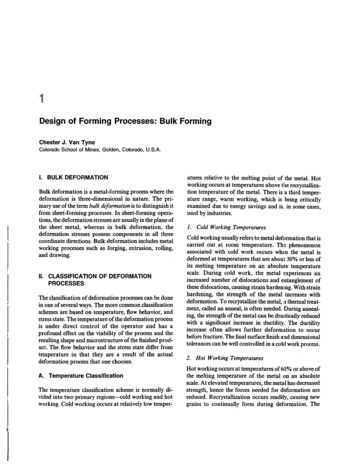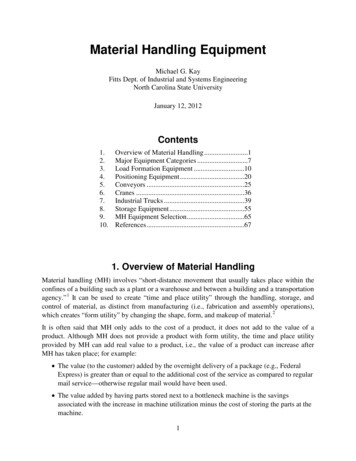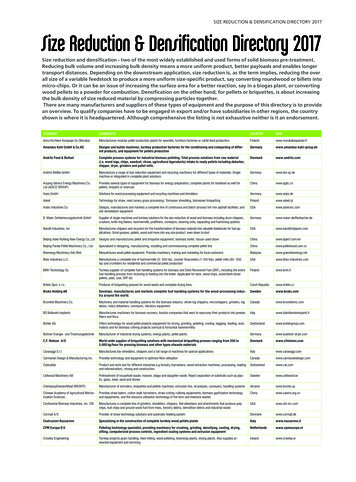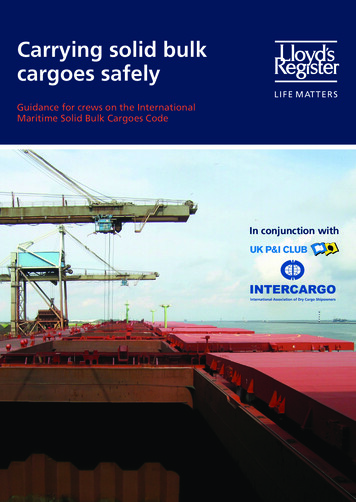
Transcription
Carrying solid bulkcargoes safelyGuidance for crews on the InternationalMaritime Solid Bulk Cargoes CodeIn conjunction with
ContentsIntroduction31. General requirements for carrying solid bulk cargoes446Accepting cargoes for shipmentLoading2. The Code’s three cargo groupsGroup A cargoes – cargoes which may liquefyGroup B cargoes – cargoes with chemical hazardsGroup C cargoes – cargoes which are neither liable toliquefy nor possess chemical hazards7810143. Other hazards associated with carrying solid bulk cargoes154. Checklist and flowchart for accepting and loading solidbulk cargoes16Appendix 1IMO regulations and guidance relating to the transport of solid bulk cargoes19Appendix 2The Code section by sectionCarrying solid bulk cargoes safely Lloyd’s Register/UK P&I Club/Intercargo, 201321Page 2
IntroductionCarrying solid bulk cargoes involves serious risks, which must be managedcarefully to safeguard the crew and the ship. These risks include reduced shipstability, (andstabilityand even capsizing,capsizing) due to cargo liquefaction; fire or explosion due tochemical hazards; and damage to ship structures due to poor loading procedures.The main legislation governing safe carriage of solid bulk cargoes is theInternational Maritime Solid Bulk Cargoes (IMSBC) Code, which becamemandatory on January 1, 2011, under the SOLAS Convention1.This pocket guide will help you understand the IMSBC Code’s key requirementsand give you greater confidence in managing the risks associatedof carrying withsolid thebulkcargoes andcarriageof solidachievingbulk cargoes.complianceIt outlineswith SOLAS.the precautionsIt outlinesyoutheshouldprecautionstake beforeyoushould oesand theforproceduresshipment andyou theshouldproceduresfollow foryousafeshouldfollow iage,the andprimarydetailshazardsthe primaryassociatedhazardswithassociatedthe differentwith thetypesof soliddifferentbulktypescargo.of solid bulk cargo.It also contains a quick reference checklist and flowchart summarising the stepsyou need to follow.Note: This guide is only an introduction to the IMSBC Code; you should alwaysNote:theThisfullguideis onlyan introductionto the forIMSBCconsultCodeto checkthe requirementseachCode;cargoyouyoushouldare carrying. Italwaysthe fullofCodetoincheckcargo youGraindoesnot consultcover carriagegrainbulk;thethisrequirementsis covered byfortheeachInternationalare carrying. It does not cover carriage of grain in bulk; this is covered by theCode.International Grain Code.Look for “Consult the Code” headings within this publication, which referLook“Consultthe ofCode”headingswithinthis publication, whichyouto forspecificsectionsthe Codefor moreinformation.refer you to specific sections of the Code for more information.1For a list of other IMO legislation and guidance relating to bulk cargoes, see Appendix 1.Carrying solid bulk cargoes safely Lloyd’s Register/UK P&I Club/Intercargo, 2013Page 3
1. General requirements forcarrying solid bulk cargoesNo matter what solid bulk cargo you are carrying, the same general requirementsapply for accepting them for shipment and loading them. Section 2 of this pocketguide covers the typical requirements for different types of cargo.Accepting cargoes for shipmentInformation required from the shipperBefore you can accept a cargo for shipment, the shipper must provide the Masterwith valid, up-to-date information about the cargo’s physical and chemicalproperties. The exact information and documentation they must provide islisted in the Code under ‘Assessment of acceptability of consignments for safeshipment; Provision of Information’, and includes the correct Bulk Cargo ShippingName2 and a declaration that the cargo information is correct.Consult the Code – see Section 4Checking the cargo scheduleIndividual cargoes are listed in‘schedules’ which are containedin Appendix 1 of the Code. Thesedescribe each cargo’s propertiesand detail the requirements forhandling, stowing and carrying itsafely. You must always consult therelevant schedule in the Code to findout what hazards the cargo presents.Consult the Code – see Appendix 12Cargo being workedThis is the cargo’s official name used in the Code.Carrying solid bulk cargoes safely Lloyd’s Register/UK P&I Club/Intercargo, 2013Page 4
Accepting cargoes not listed in the IMSBC CodeThe list of individual cargoes contained in the Code is not exhaustive. If a cargonot listed in the Code is presented for shipment, the shipper and the appropriatecompetent authorities3 must follow this process:1. Before loading, the shipper must provide details of the characteristics andproperties of the cargo to the competent authority of the port of loading.2. Based on this information the competent authority of the port of loadingwill assess the acceptability of the cargo for shipment.– If the assessment defines the cargo as Group A or B4, the competentauthorities3 will set the preliminary suitable conditions for carriage.– If the cargo is Group C4 then carriage can be authorised by the port ofloading and the competent authorities of the unloading port and flagstate will be informed of the authorisation.3. In both cases, the competent authority of the port of loading will give theMaster a certificate stating the characteristics of the cargo and the requiredconditions for carriage and handling. The competent authority of the port ofloading will also provide the same information to the IMO.Consult the Code – see Section 1.3ExemptionsUnder section 1.5 of the Code, a competent authority (or authorities) can grant anexemption which allows ships to carry a cargo outside the requirements specifiedin its schedule, provided that equivalent provisions have been put in place.Agreement of all three competent authorities is required to ship a cargo underan exemption. Acceptance of an exemption by authorities not party to it isdiscretionary: i.e., if the loading port authority issues an exemption, the unloadingport and flag state authorities can choose to accept it or reject it.An exemption can be valid for up to five years and does not necessarily lead to thecreation of a new or revised schedule.Consult the Code – see Section 1.534The competent authorities of the port of loading, the port of unloading and the flag state.The Code categorises cargo into three Groups – A, B and C. See page 7 for their definitions.Carrying solid bulk cargoes safely Lloyd’s Register/UK P&I Club/Intercargo, 2013Page 5
LoadingInspecting and preparing cargo spacesIn general, before loading a cargo you must inspect and prepare the cargo spaces,checking that:– bilge wells and strainer plates are prepared to facilitate drainage and preventcargo entering the bilge system– bilge lines, sounding pipes and other service lines are in good order– cargo space fittings are protected from damage, and– measures are in place to minimise dust entering living quarters or otherinterior spaces, or coming into contact with moving parts of deck machineryand external navigational aids.Distribution and stabilityYou must also make sure that cargoes are properly distributed throughout theship’s holds to provide adequate stability and ensure that the ship’s structure isnever overstressed. Information can be found in the ship’s stability informationbooklet or you can use loading calculators if they are available. The Master willneed to calculate the stability for the anticipated worst conditions during thevoyage as well as for departure and demonstrate that the stability is adequate.Loading PlanBefore loading or unloading, the Master and the terminal representative mustagree a Loading Plan to ensure that the permissible forces and moments on theship are not exceeded. What this Plan should include is detailed in the Code ofPractice for the Safe Loading and Unloading of Bulk Carriers (the BLU Code) andin the checklist on page 16.Carrying solid bulk cargoes safely Lloyd’s Register/UK P&I Club/Intercargo, 2013Page 6
2. The Code’s three cargo groupsThe IMSBC Code categorises cargoes into three groups:Group A – cargoes which may liquefy if shipped at a moisture content exceedingtheir Transportable Moisture Limit (TML)5.Group B – cargoes which possess a chemical hazard which could give rise to adangerous situation on a ship.Group C – cargoes which are neither liable to liquefy (Group A) nor possesschemical hazards (Group B). Cargoes in this group can still be hazardous.You can find the Group for a particular cargo in its schedule.Liquefied nickel ore (Image courtesy of MTD)5The TML is the maximum moisture content considered safe for carriage. See page 9.Carrying solid bulk cargoes safely Lloyd’s Register/UK P&I Club/Intercargo, 2013Page 7
Group A cargoes (cargoes which may liquefy)What is liquefaction and how does it affect cargo?Liquefaction means that a cargo becomes fluid (liquefies). On ships, this happenswhen the cargo is compacted by the ship’s motion. Cargoes which are prone toliquefaction contain a certain quantity of moisture and small particles, although theymay look relatively dry and granular when loaded. Liquefaction can lead to cargoshift6 and even to the capsize and total loss of the ship, and can occur even whencargoes are cohesive and trimmed level.Consult the Code – see Section 7Examples of Group A cargoesMineral concentratesMineral concentrates are refined ores in which valuable components have beenenriched by eliminating most waste materials. They include copper concentrate,iron concentrate, lead concentrate, nickel concentrate and zinc concentrate.Nickel ore7There are several types of nickel ore whichvary in colour, particle size and moisturecontent. Some may contain clay-like ores.CoalCoal (bituminous and anthracite) is anatural, solid, combustible materialconsisting of amorphous carbon andhydrocarbons. It is best known as a GroupB cargo due to its flammable and selfheating properties, but it can also beclassed as Group A because it can liquefy ifpredominantly fine (i.e., if 75% is made upof particles less than 5mm in size). In thesecases, it is classed as both Group A and B.Coal being loaded. Coal is mostcommonly a Group B cargo, butcan also be classed as both A and B.Cargo shift can be divided into two types: sliding failure or liquefaction consequence. Trimming thecargo can prevent sliding failure.Nickel ore is not to be confused with nickel concentrate.67Carrying solid bulk cargoes safely Lloyd’s Register/UK P&I Club/Intercargo, 2013Page 8
Typical requirements for acceptingand loading Group A cargoesInformation required from the shipperTo control the risks of liquefaction, GroupA cargoes are tested to determine theirTransportable Moisture Limit (TML) andtheir actual moisture content before theycan be shipped. The TML is the maximummoisture content considered safe for carriage.The actual moisture content of the cargomust be below the TML.The information supplied by the shipperto the master must include a signedcertificate stating the TML, and a signedcertificate or declaration of the cargo’sactual moisture content.Hui Long, a bulk carrier whichsank in 2005. The cause wasbelieved to be liquefaction,possibly due to the TMLbeing exceeded.What you need to doFollow these steps when carrying Group A cargoes to reduce the risk of liquefaction:– Make sure the shipper has supplied the required information, including theTML and the actual moisture content.– Only accept the cargo if the actual moisture content is less than its TML.– Carry out visual monitoring during loading. If there are any indications of highmoisture content, stop loading and seek further advice.– Consider trimming the cargo to reduce the likelihood of cargo shift.– Take measures to prevent water or other liquids entering the cargo spaceduring loading and throughout the voyage.Practical guidance on managing the risks of liquefaction is also available from theUK P&I Club at www.ukpandi.com/loss-preventionConsult the Code – see Sections 7 and 8Carrying solid bulk cargoes safely Lloyd’s Register/UK P&I Club/Intercargo, 2013Page 9
Group B cargoes (cargoes with chemical hazards)Group B cargoes are classified in two ways within the Code: ‘Dangerous goodsin solid form in bulk’ (under the International Maritime Dangerous Goods (IMDG)Code; and ‘Materials hazardous only in bulk’ (MHB).You will find this information in the “characteristics” section of the cargo’sschedule. Cargoes classified as dangerous goods in solid form in bulk will alsohave a ‘UN’ number in the Bulk Cargoes Shipping Name.Consult the Code – see Section 9Dangerous goods in solid form in bulkIn the Code these cargoes are classed as follows:Class 4.1: Flammable solidsClass 4.2: Substances liable to spontaneous combustionClass 4.3: Substances which, in contact with water, emit flammable gasesClass 5.1: Oxidizing substancesClass 6.1: Toxic substancesClass 7: Radioactive materialsClass 8: Corrosive substancesClass 9: Miscellaneous dangerous substances and articles.Materials hazardous only in bulk (MHB)MHB cargoes are materials which possess chemical hazards when transported in bulk thatdo not meet the criteria for inclusion in the IMDG classes above. They present significantrisks when carried in bulk and require special precautions. They are described as follows:Combustible solids: materials which are readily combustible or easily ignitableSelf-heating solids: materials that self-heatSolids that evolve into flammable gas when wet: materials that emitflammable gases when in contact with waterSolids that evolve toxic gas when wet: materials that emit toxic gases whenin contact with waterToxic solids: materials that are acutely toxic to humans if inhaled or brought intocontact with skinCorrosive solids: materials that are corrosive to skin, eyes, metals or respiratory sensitisers.Carrying solid bulk cargoes safely Lloyd’s Register/UK P&I Club/Intercargo, 2013Page 10
Examples of Group B cargoes and the risks they presentThe major risks associated with Group B cargoes are fire and explosion, release oftoxic gas and corrosion.CoalCoal may create flammable atmospheres, heat spontaneously, deplete oxygenconcentration and corrode metal structures. Some types of coal can producecarbon monoxide or methane.Direct reduced iron (DRI)DRI may react with water and air toproduce hydrogen and heat. The heatproduced may cause ignition. Oxygenin enclosed spaces may also be depleted.Metal sulphide concentratesSome sulphide concentrates areprone to oxidation and may have atendency to self-heat, leading to oxygendepletion and emission of toxic fumes.Some metal sulphide concentrates maypresent corrosion problems.Organic materialsAmmonium nitrate-based fertilisersAmmonium nitrate-based fertiliserssupport combustion. If heated,contaminated or closely confined,they can explode or decompose torelease toxic fumes and gases.The damage caused by a DRI explosion(Image courtesy of Burgoynes)Wood products transported in bulk8Wood products transported in bulk are listed in a new schedule to the Code:Wood Products – General. They include logs, pulpwood, roundwood, saw logsand timber. These cargoes may cause oxygen depletion and increase carbondioxide in the cargo space and adjacent spaces.These are wood products loaded and discharged by methods such as elevatorsand grabs. They are distinct from wood products listed in other schedules.8Carrying solid bulk cargoes safely Lloyd’s Register/UK P&I Club/Intercargo, 2013Page 11
Typical requirements for accepting and loading Group B cargoesInformation required on board ship for dangerous goods in solid form in bulkTo carry dangerous goods in solid form in bulk, your ship must have a Documentof Compliance for the Carriage of Dangerous Goods, supplied by the ship’s flagor classification society. The Master must have a special list, manifest or stowageplan identifying the cargo’s location, and there must be instructions on board foremergency response.SegregationBecause of their potential hazards, many Group B cargoes are incompatible andmust be segregated. When segregating cargoes, you should take into account anysecondary risks they present.Consult the Code – see Section 9.3Coal on fire in a cargo holdCarrying solid bulk cargoes safely Lloyd’s Register/UK P&I Club/Intercargo, 2013Page 12
Specific risk mitigation measuresThe cargo’s schedule and the information provided by the shipper will detail theprecautions you must take when carrying Group B cargoes. The following aresome of the common risk mitigation measures you will employ.Fire and explosionDepending on the cargo, precautions against fire and explosion may includeventilating or inerting the cargo holds and the enclosed spaces adjacent tothe holds: in some cases the ventilators will need to be explosion proof. Theatmosphere in the cargo holds and the enclosed spaces adjacent to the holdsmay also need to be monitored with an appropriate gas detector.Toxic gasToxic gas risks will be mitigated using natural or forced mechanical ventilation.The choice of ventilation will depend on the type of cargo and the propertiesof the gas (i.e., whether it creates an explosive atmosphere). You may need tomonitor the cargo hold atmosphere.CorrosionCorrosion can be caused by some Group B cargoes and their residues. A coatingor barrier may need to be applied to the cargo space structures before loading.Before loading and unloading corrosive cargoes, make sure the cargo space isclean and dry.DRI which has self heated (Image courtesy of Burgoynes)Carrying solid bulk cargoes safely Lloyd’s Register/UK P&I Club/Intercargo, 2013Page 13
Group C cargoes (cargoes which are neither liable to liquefy norpossess chemical hazards)Although Group C cargoes do not present the dangers associated with GroupA and B cargoes, they can still carry risks.Examples of Group C cargoes, their risks and mitigation measuresIron ore and high density cargoesThese cargoes can be extremely dense and can overstress the tanktop. Makesure that their weight is evenly distributed during loading and during the voyageso that the tanktop is not overstressed, and also consider trimming the cargo.Loading rates of iron ore are normally very high and you should also consider theship’s ballasting operations and loading sequences.Sand and fine particle materialsFine particle materials can be abrasive. Silica dust is easily inhaled and can resultin respiratory disease.You should take appropriate precautions to protect machinery andaccommodation spaces from the dust of sand and fine particle cargoes, and toprevent the cargo from getting into the bilge wells. People who may be exposedto cargo dust should wear goggles or other equivalent dust eye-protection, dustfilter masks and protective clothing.CementCement may shift when aerated during loading. Dust can also be produced fromthis cargo. Follow the precautions for sand and fine particle materials (above).Carrying solid bulk cargoes safely Lloyd’s Register/UK P&I Club/Intercargo, 2013Page 14
3. Other hazards associated with carryingsolid bulk cargoesEntering enclosed spacesAlways follow the appropriate procedures before entering an enclosed space, takinginto account IMO Resolution A.1050(27) – Revised Recommendations for EnteringEnclosed Spaces Aboard Ships. Note: after a cargo space or tank has been tested andgenerally found to be safe for entry, small areas may exist where oxygen is deficient ortoxic fumes are still present.PesticidesThe risks of using pesticides include the accumulation of gas in spaces adjacentto the cargo holds being treated or, if it is essential to ventilate the cargo holds,accumulation of fumigant in accommodation and working areas.Fumigants such as Phosphine and Methyl Bromide are poisonous to humans and ifthey are not handled correctly, they can also represent a fire risk. They should onlybe used by specialists and not by the ship’s crew.Carry out any fumigation in line with the IMO Circular, MSC.1/Circ.1264 –Recommendations on the Safe Use of Pesticides in Ships Applicable to theFumigation of Cargo Holds. This is contained in the supplement to the Code.The ship should carry gas-detection equipment, adequate respiratory protectiveequipment, a copy of the latest version of the Medical First Aid Guide for Use inAccidents Involving Dangerous Goods (MFAG), and appropriate medicines andmedical equipment.Carrying solid bulk cargoes safely Lloyd’s Register/UK P&I Club/Intercargo, 2013Page 15
4. Checklist and flowchart for acceptingand loading solid bulk cargoesThe checklist on the next two pages and the loading flowchart on page 18 bringtogether all the key procedures you must follow when accepting and loading any solidbulk cargo for shipment. Always consult the Code itself to ensure that all mandatorymeasures and specific advice have been implemented.Download a large version of the flowchart at www.lr.org/imsbcChecklistBefore accepting and loading a cargo, ask yourself the following questions:1. Has the shipper delivered the cargo information and documentation listed inthe Code under ‘Assessment of acceptability of consignments for safe shipment;Provision of Information’, including the correct Bulk Cargo Shipping Name(BCSN), and provided a declaration that the cargo information is correct?2. Have you consulted the relevant IMSBC Code schedule to find out the cargo’sgeneral and specific hazards?3. If the cargo is listed as Group A, have you followed all procedures relatingto the safe carriage of cargoes which may liquefy?4. If the schedule indicates the cargo is Group B has the shipper provideda statement that the chemical characteristics of the cargo are, to the bestof his knowledge, those present at the time of loading?a) If the cargo is classified as ‘dangerous goods in solid form in bulk’ does theMaster have a special list, manifest or stowage plan identifying its location,are there instructions on board for emergency response, and does the shiphave a Document of Compliance for the Carriage of Dangerous Goods?(Continued on the next page)Carrying solid bulk cargoes safely Lloyd’s Register/UK P&I Club/Intercargo, 2013Page 16
Checklist (continued)5. Whatever the cargo Group, have you taken the recommended precautionsto remove or minimise the cargo’s hazard, including:a) preparing recommended safety equipment and procedures?b) activating any cargo monitoring equipment ready for loading?6. Have the Master and Terminal Representative agreed a Loading Plan to ensurethat the permissible forces and moments on the ship are not exceeded duringloading or unloading? This should include the sequence, quantity and rate ofloading or unloading, the number of pours and the de-ballasting or ballastingcapability of the ship.7. Are there instructions to suspend the loading or unloading operation ifthe ship’s limits are exceeded, or are likely to be exceeded if the operationcontinues?8. Are you monitoring the cargo loading or unloading procedure, is the ship’sdraught being monitored and recorded in the logbook, and have any significantdeviations been corrected?9. Before sailing on the loaded passage, have you considered other factors, suchas the ingress of water, which could affect the cargo during the passage?Carrying solid bulk cargoes safely Lloyd’s Register/UK P&I Club/Intercargo, 2013Page 17
Loading flowchart – follow the steps to see if it is safe to load your cargoYESNOShipper has delivered all required cargo information?IMSBC Code consulted regarding cargo and associated hazards?Master and crew have the necessary ship data and information to prepare ship for loading?Cargo spaces inspected and prepared for cargo loading and stowage?NONONOCargo Group?ABTML Certificate?Stowage/segregationacceptable?MC lower than TML?Atmospheric conditionssuitable and monitoringtools operational?Cargo spaces freefrom liquids?Applicable dustprecautions in place?Visual monitoringconducted?Ventilation meetsoperational andIMSBC requirements?Trimming considered?Not listed inIMSBC Code?CIMSBC Cargo Scheduleconsulted?Applicable precautionstaken?Competent authorityhas provided the Masterwith certificate statingcarriage requirements(if Group A or B,agreed by authorityof port of unloadingand flag)?YESDO NOT LOADMoisture content(MC) declaration?NOIs the cargo categorised as ‘dangerous goods in solid form in bulk’ by SOLAS regulation VII/7?NODoes the Master have a special list/manifest/stowage plan identifying its location, arethere instructions on board for emergency response, and does the ship have a‘Document of Compliance for the Carriage of Dangerous Goods’?Has the Loading Plan been agreed with the Master and terminal representative?Are there instructions to suspend the loading/unloading operation if the ship’s limits areexceeded, or are likely to be exceeded if continued?NONONOLOAD (monitoring the cargo loading operation)Carrying solid bulk cargoes safely Lloyd’s Register/UK P&I Club/Intercargo, 2013Page 18
Appendix 1 – IMO regulations and guidancerelating to the transport of solid bulk cargoesMandatory regulationsInternational Convention for the Safety of Life at Sea (SOLAS)– Chapter VI: Carriage of cargoes– Chapter VII: Carriage of dangerous goods– Chapter XII: Additional safety measures for bulk carriersInternational Maritime Solid Bulk Cargoes (IMSBC) Code – facilitates the safestowage and shipment of solid bulk cargoes by providing information on the risksassociated with their shipment, and the procedures to be adopted for carriage.International Code for the Safe Carriage of Grain in Bulk(International Grain Code) – contains regulations and guidance for shipsengaged in the carriage of grain in bulk.Code of Safe Practice for Ships Carrying Timber Deck Cargoes – providesstowage, securing and other operational safety measures designed to ensure thesafe transport of timber cargoes, primarily stowed on deck.MARPOL Annex V – Regulations for the Prevention of Pollution byGarbage from Ships – includes requirements for discharge of dry bulk cargoresidues and cargo hold wash-water containing cargo residues.GuidanceCode of Practice for the Safe Loading and Unloading of Bulk Carriers (BLU Code)– assists those responsible for the safe loading or unloading of bulk carriers tocarry out their functions and to promote the safety of bulk carriers.Circulars and Resolutions– MSC.1/Circ.1160 – Manual on Loading and Unloading of Solid Bulk Cargoesfor Terminal Representatives.– MSC. 1/Circ.1357 – Additional Considerations for the Safe Loading of Bulk CarriersCarrying solid bulk cargoes safely Lloyd’s Register/UK P&I Club/Intercargo, 2013Page 19
Circulars and Resolutions (continued)– MSC. 1/Circ.908 – Uniform Method of Measurement of the Density of BulkCargoes– MSC. 1/Circ.1395 – Lists of Solid Bulk Cargoes for which a Fixed GasFire-extinguishing System may be Exempted or for which a Fixed Gas Fireextinguishing System is Ineffective– Resolution A.1050(27) – Revised Recommendations for Entering EnclosedSpaces Aboard Ships– MSC. 1/Circ.1264 – Recommendations on the Safe Use of Pesticides in ShipsApplicable to the Fumigation of Cargo Holds– BC. 1/Circ.69 – Contact Names and Addresses of the Offices of DesignatedNational Competent Authorities Responsible for the Safe Carriage of Grain andSolid Bulk Cargoes.Carrying solid bulk cargoes safely Lloyd’s Register/UK P&I Club/Intercargo, 2013Page 20
Appendix 2 – the Code section by sectionSection 1 – General provisions – including application, definitions, related SOLASregulationsSection 2 – General loading, carriage and unloading precautions – cargodistribution and loading/unloading proceduresSection 3 – Safety of personnel and ship - poisoning, corrosive and asphyxiationhazards, dust hazards, flammability and ventilationSection 4 – Assessment of acceptability of consignments for safe shipment –identification of cargoes, and the tests and documentation required for their safecarriageSection 5 – Trimming proceduresSection 6 – Methods of determining angle of reposeSection 7 – Cargoes that may liquefy – the dangers of liquefaction, conditionsunder which liquefaction may take place and precautions to prevent itSection 8 – Test procedures for cargoes that may liquefySection 9 – Materials possessing chemical hazards – classification of hazards,stowage and segregation requirementsSection 10 – Carriage of solid bulk wastes – their classification, segregationand stowageSection 11 – Security provisionsSection 12 – Stowage factor conversion tablesSection 13 – References to related information and recommendationsAppendicesAppendix 1 – Individual schedules of solid bulk cargoesAppendix 2 – Laboratory test procedures, associated apparatus and standardsAppendix 3 – Properties of solid bulk cargoesAppendix 4 – Index of solid bulk cargoesSupplement – this contains supporting documents including the BLU Code andIMO circulars (see Appendix 1)Carrying solid bulk cargoes safely Lloyd’s Register/UK P&I Club/Intercargo, 2013Page 21
Lloyd’s Register is an independent risk management organisation that works to improveits clients’ quality, safety, environmental and business performance throughout theworld. Our expertise and activities cover shipping, railways, other land-based industriesand oil and gas. Working from around 245 locations we employ some 7,600 personnel.We operate independently of any government or other body.Lloyd’s Register is a trading name of Lloyd’s Register Group Limited and its subsidiaries.For further details please see www.lr.org/entitiesTo order additional copies of this pocket guide, please visit the Lloyd’s Register webstore:www.webstore.lr.orgAbout the UK P&I ClubOne of the world’s largest P&I mutuals, the UK P&I Club currently insures around 200million gross tons of owned and chartered ships in 60 countries.The Club publishes loss prevention material through a wide range of media on topics suchas hazardous cargo in containers, human error, personal injury and maritime se
carefully to safeguard the crew and the ship. These risks include reduced ship stability, and even capsizing, due to cargo liquefaction flre or explosion due to chemical hazards and damage to ship structures due to poor loading procedures. The main legisla
